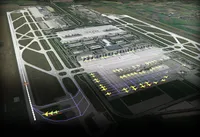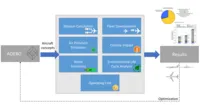Analysis and Evaluation of Aircraft Concepts
The research activities within the field of analysis & evaluation are aimed for an integral and overall evaluation of aircraft concepts and system solutions.
To enable an overall evaluation capability, the areas flight & mission performance, global and local emissions, airport capacity, airline operative cost including the integration of environmental aspects are included in an aligned and integrated approach. This approach enables a balanced consideration of the main driving requirements for new aircraft solutions.
Selection of partners in current or completed projects:
Airbus, Bauhaus Luftfahrt, Boeing, ENVISA, Eurocontrol, Flughafen München, Lufthansa, NLR, QinetiQ, SINTEF, University of Leeds
The evaluation of novel, conceptual aircraft designs on the basis of operational parameters is in many respects a central objective of early phases of aircraft conceptual design. With the methodologies utilized in the research areas Aircraft Design and Future Trends & Technologies, as well as those developed within the framework of this research area, a wide range of possibilities are available, whose combination allows a more holistic view of the operation of future aircraft. Here, the focus is set on promising technologies to significantly decrease the environmental footprint of aviation, such as hydrogen or battery-powered (hybrid) aircraft. Methods for calculating emissions and climate impact during operation as well as complete life cycle analyses for ecological assessment and methods for determining direct operating costs for the economic analysis of these aircraft are being (further) developed at the Institute of Aircraft Design and in the first place applied at single aircraft level or on exemplary missions. To this end, special emphasis is paid to the comparison with existing or advanced conventional technologies, for which, in addition to the consideration of individual missions, the overall fleet view becomes central. In this way, the effects of new technologies on the fleet structure are estimated in dependence of entry-into-service dates and production capacities. Within the scope of a technology impact assessment, air traffic emissions are calculated for specific scenarios and placed in relation to each other. Effects of new technologies on the climate impact of aviation can thus be quantified on a global scale according to the technology’s fleet uptake. This holistic concept evaluation permits, among others, conclusions to be drawn about influential aircraft parameters as well as the significance of production capacities for achieving given climate targets.
| Contacts | Anna Elena Scholz, Kristina Kossarev, Johannes Michelmann |
| Project website | here |
In the context of the ongoing development of Advanced Air Mobility (AAM) concepts, one particular challenge is the integration in the existing airspace structure. The project “AMI-AirShuttle” aims to develop a holistic solution that enables flights of vertical take-off capable air taxis (VTOL) at commercial airports without restricting the existing conventional air traffic. The Chair of Aircraft Design contributes to the project by developing slot-neutral arrival and departure trajectories, as well as evaluating the expected additional air traffic noise in the vicinity of the airport. In further workpackages, the project partners prepare a viable operational concept, design the landing site at the airport (called “Vertiport”), including all necessary ground handling processes, and evaluate the public acceptance and user experience. The project is embedded in the Holistic Air Mobility Initiative, funded by the Free State of Bavaria, and led by Munich Airport International (MAI) and Airbus with the involvement of several partners across research and industry.
| Kontakt | Theresa Berens, Xueqing Nie, Johannes Michelmann, Michael Schmähl |
| Projektseite | AMI-AirShuttle |
For applications of cargo delivery drones in urban area high acceptance of population needs to be taken into consideration. UmSiTrUL (Umweltfreundliche und sichere eVTOL Transporte im Urbanen Luftraum) project has a goal to develop the noise models for two representative cargo unmanned aerial vehicle for using in lower urban flight areas. The flights should be optimized concerning noise development and therefore the models developed in this project should as precise as possible. The result of UmSiTrUL project should be the creation of semi-empiric noise models based on measurement data of real flights as well as on simulations results for hover, transition and cruise flights.
| Contact | Illia Peleshok, Michael Schmähl |
Urban air mobility (UAM) applications like air taxis or cargo unmanned aerial vehicles (UAV) are currently developed by various aviation companies all around the world. Many of these aerial vehicles are multi rotor systems which show rather complex aeroacoustic noise generation mechanisms. The target of ProMeDRaS (German acronym for: “propeller optimization and meta material integration in UAV design for noise reductions”) is to develop noise reduction methods for the design process of cargo UAVs. The main task of the Chair of Aircraft Design is to analyze the noise generation and propagation of a real-life propeller configuration based on noise measurement data and high-fidelity computational fluid dynamics (CFD)/Ffowcs Williams-Hawkings (FW-H) noise simulation and to implement and validate a mixed-fidelity acoustic propeller optimization program.
| Contact | Michael Schmähl |
The Institute of Aircraft Design is conduction research in the area of noise analysis and optimization of UAV systems. Urban air mobility (UAM) applications operate close to urban areas, thus, design and operation of UAV systems are precondition to gain public acceptance. On one hand, the institute is conducting flight noise measurements with an in-house developed noise measurement system. The noise data can be used for noise modeling and other purposes. On the other hand, high-resolution 3D CFD computations are conducted during which a Ffowcs-Williams Hawkings solver computes the noise radiation of the whole aircraft. The combination of both methodologies allows the analysis of existing aircraft and prototypes as well as the analysis of virtual aircraft models in the sense of a virtual prototype. The methodologies can basically be applied to manned aircraft as well.
| Contact | Michael Schmähl |

The aim of the project RAUMOLES (Raumbezogene Modellierung zur Lärmreduktion elektrischer Senkrechtstarter) was to create eVTOL UAV noise models and to integrate them into a geodata model for planning purposes. This interface is a precondition for future flight corridor planning processes in urban areas that take noise issues into account. The Institute of Aircraft Design conducted noise measurements of two cargo eVTOL UAVs and created semi-empiric noise models for horizontal as well as vertical flight from that database.
| Partner | Phoenix Wings, Prof. Schaller UmweltConsult |
| Contact | sekretariat(at)lls.lrg.tum.de |
The project consists of the implementation of a model simulating the influence of aeronautical infrastructure capacity limitations on air traffic development. The impact of restrictions on airside airport capacity and airspace capacity on air traffic and fleet development will be examined with this model. This work will build on previous work at the LLS regarding the calculation of airport capacities, but also regarding traffic and fleet development as well as network structures. Using scenario techniques, different scenarios for infrastructure development are generated and different interaction mechanisms between traffic development and its infrastructural limitations are considered.
Increasing air traffic growth causes increased noise emissions in the vicinity of airports under otherwise constant conditions. In addition, the impact of aircraft noise is intensified by a population growth in the vicinity of large airports, which is usually significant as a result of urbanization. New solutions in the field of aircraft noise management and noise reduction measures are therefore urgently needed and are therefore the subject of research by the Institute of Aircraft Design. In a study for the Luftamt Südbayern, the chair investigated a large number of different noise reduction measures. In the work, restrictive measures, economic instruments and operational measures for approaches, departures and ground operations were analyzed and evaluated in detail.
At discrete points, aircraft noise measurements can provide precise insights into the current noise immission at an airport. If a non-discrete, comprehensive picture of the aircraft noise situation of an entire airport environment is to be generated, computer simulations are a suitable tool. The Institute of Aircraft Design models airport operations under acoustic considerations for the calculation of aircraft noise contours. Advanced models are used which are able to derive equivalent continuous noise levels and impact figures from the noise emission of individual aircraft types, the flight plan and the geometric infrastructure of an airport.
The interaction at airports, which determines future aircraft noise situations, is highly complex. The Institute of Aircraft Design develops methods and simulation capabilities that can be used to comprehensively analyze influences on future noise immissions at airports. Under the aspect of technology assessment, the influence of noise reductions of future aircraft types at the airport level can be quantified and evaluated taking into account future air traffic growth, the decommissioning of aircraft as well as the future commissioning behavior.

MIME examines whether it is possible to set up a system of tradable certificates for aircraft noise. The aim is to enable effective aircraft noise control that is more cost-effective than conventional mechanisms such as taxes and noise charges.
| Partner | SINTEF, NLR, ITS, EnvIsa, QinetiQ, EUROCONTROL |
| Contact | sekretariat(at)lls.lrg.tum.de |
Methodical support of the product development of complex product structures from the point of view of modular variant management in commercial aviation.
| Partner | Airbus Operations GmbH |
| Contact | sekretariat(at)lls.lrg.tum.de |
Within the framework of this research work, attempts are made to derive representative environmental parameters for the current point in time on a global level. Furthermore, a statement on the future development of the representative environmental parameters is to be made with the help of the scenario technique.
| Partner | - |
| Contact | sekretariat(at)lls.lrg.tum.de |

Development of a methodology to model the impact of aircraft parameters on the air traffic at airports with the aim to quantify the resulting airport capacity.
| Partner | - |
| Contact | sekretariat(at)lls.lrg.tum.de |






